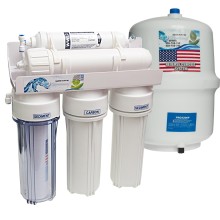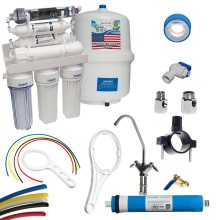- today
- label Plant cultivation
- favorite 2 likes
- remove_red_eye 4739 views
- comment 0 comments

Osmotic Water - What Is It?
Osmotic water, also known as water obtained through reverse osmosis, is water purified from most contaminants, salts, bacteria, viruses, and other dissolved substances. The reverse osmosis (RO) process involves water passing through a special semi-permeable membrane under high pressure. This membrane is tight enough to retain most particles found in the water, only allowing water molecules to pass through.
As a result of this process, water with a very low concentration of dissolved substances is obtained, indicated by low electrical conductivity (EC). Osmotic water is used in many applications, including gardening, medicine, pharmacy, the cosmetic industry, aquaristics, as well as a primary component in some industrial processes and for irrigation in precision plant cultivation systems, where it is crucial to provide water free from undesirable salts and pollutants.
The use of osmotic water in cultivation allows for full control over the chemical composition of the irrigation solution, which is especially important in hydroponic and aeroponic cultures, where plants receive all nutrients solely from the water solution. This enables the maximization of nutrient absorption efficiency by the plants and minimizes the risk of problems related to excess salts in the water that could harm the plants.
Why Is Osmotic Water Often Used in Indoor Cultivations?
Usually, there's no possibility to supply home cultivation with rainwater, which would be the optimal solution, but often there's a problem with it. Even if someone is able to collect it, in some places it is unfortunately contaminated due to atmospheric pollution. "Tap water" contains lime (so-called hardness) and other salts, e.g., iron compounds, chlorine, etc., its EC can be 0.5 mS or more. Typically, in large cities, especially those located in the middle or lower course of rivers, the water is simply quite poor.
Meanwhile, fertilizer manufacturers recommend on labels the doses that should be given using high-quality water, with an EC of 0.3. The raw material we have plenty of from water supply systems does not fully meet the plants standing indoors. Advanced growers use reverse osmosis filters to prepare an excellent nutrient solution. Tap water is mixed with RO water (reverted osmosis); this demineralized and ion-free water cannot be used in "100% concentration" because then it would not be possible to regulate its pH with, for example, phosphoric or nitric acid. There's no iron rule on the proportions to combine because the tap water is also different in different places. The aim is to achieve an EC value of 0.3. Hydro conducted professionally cannot do without a meter anyway.
Many, despite years spent on this hobby, hesitate whether to invest in a reverse osmosis installation. Until recently, it was a significant expense (which has changed significantly), besides, they do not feel sure whether the results will be worth trying. Today, just look at the prices and efficiency as well as the lifespan of the equipment, calculate your demand, and it does not come out that much. Certainly, however, it absolutely does not make sense to even consider the cheapest spring water or distilled/demineralized for batteries, irons, etc.! Another note on the margin – water devoid of ions, minerals is not suitable for consumption by humans or animals: it draws salts from organisms, which is unhealthy, harmful. Filters are available commercially, also by mail order. The more plants we have, the more it pays off.
What Does It Actually Give?
Better yields. Numerous growers strive for extra effects using various, often expensive supplements, without success. It's essential to understand that despite the presence of complete fertilizers in the solution, the plant cannot absorb it all when the water is salty from the start. Gadgets like Bloom Booster have significantly limited application. The impact of poor water quality is most evident in hydroponics or aeroponics, where deficits of macro and microelements often occur. The best example is phosphorus deficiency, which leads to weaker condition and poorer flowering, manifesting in reddish stems. Filtration mitigates such threats. In soil cultivations and in coconut fiber, the difference is visible but not as striking. Another potential problem is contaminated water. If we give the "right" dose of fertilizer, the EC will be too high. It indicates the overall amount of minerals in the water, and depending on the size, age, rate of metabolism, the plants require a specific content; since there's already some from pollutants (high primary EC of the water itself), it results in crossing the threshold, excessive concentration. Salts not fully absorbed create increased deposits on parts of the installation, and worse, they accumulate in the substrate; even ignoring the future ecological aspect of this phenomenon, it harms the roots, blocks the uptake of water or further elements, poses a threat to the health of the cultivation. Attempting to combat deficiencies potentially leads to over-fertilization.
Benefits of Using Osmotic Water Beyond Cultivations:
- Aquaristics: Osmotic water is valuable in breeding certain species of fish and aquarium plants, especially those requiring specific chemical conditions of water.
- Pharmaceutical and Cosmetic Industry: High-purity water is essential in the production of medicines and cosmetics to ensure the safety and effectiveness of products.
- Food Industry: In the food industry, osmotic water can be used to prepare beverages and food products where high water purity is crucial.
Alternative Water Purification Methods:
- Activated Carbon Filtration: Removes chlorine, some organic pollutants, and improves the taste and smell of water, but it's not as effective in removing salts and other mineral substances.
- Distillation: Allows obtaining very high purity water through its evaporation and condensation, but it's an energy-intensive and less energy-efficient process than reverse osmosis.
- Ion Exchange (Water Softeners): Effective in reducing water hardness by removing calcium and magnesium, but they do not remove most other contaminants.
Comparison of Methods:
While reverse osmosis is one of the most effective water purification methods, allowing the removal of a wide range of contaminants, including viruses, bacteria, and salts, other methods may be preferred depending on specific needs and water quality expectations. It's important to understand that choosing the right purification method should be based on the analysis of the incoming water quality and the requirements for its use.
As long as we don't have access to ecological rainwater, osmotic systems offer an opportunity to realize the full growth potential of plants, enabling optimal nutrient absorption and, as a result, significantly increased production.





Comments (0)